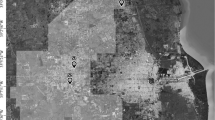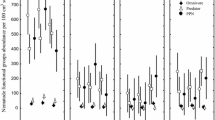Abstract
Nematode colonization and succession were studied over 60 weeks in field plots which had been disturbed by combinations of fumigation and manuring. It was expected that the Maturity Index, which is based on the composition of the nematode fauna, would decrease after disturbance, and subsequently increase with recovery and succession. The results showed that in all treatments, the initial colonization and growth were due to taxa scaled in colonizer-persister (c-p) group 1, resulting in a low Maturity Index. An increase in this index followed when these taxa were gradually replaced by c-p group 2 which thereafter remained the dominant group. C-p groups 3–5 developed only in the non-fumigated treatment. Manuring caused characteristic changes in the nematode fauna which could be described as a cycle, starting with an increase in enrichment opportunists (c-p 1), which were succeeded by general opportunists (c-p 2) which, in turn, were supplemented with persisters (c-p 3–5). It is expected that the same cycle will be observed as a result of other disturbances that cause temporary increase in food supply.
Similar content being viewed by others
References
Bongers T (1988) De nematoden van Nederland. Natuurhistorische Bibliotheek van de KNNV, nr 46. Pirola, Schoorl, The Netherlands
Bongers T (1990) The maturity index: An ecological measure of environmental disturbance based on nematode species composition. Oecologia 83:14–19
Bongers T, van der Haar J (1990) On the potential of basing an ecological typology of aquatic sediments on the nematode fauna: An example from the river Rhine. Hydrobiol Bull 24:37–45
Bongers T, Alkemade R, Yeates GW (1991) Interpretation of disturbance-induced maturity decrease in marine nematode assemblages by means of the Maturity Index. Mar Ecol Prog Ser 76:135–142
Clarholm M, Popovic B, Rosswall T, Söderström B, Sohlenius B, Staff H, Wirén A (1981) Biological aspects of nitrogen mineralization in humus from a pine forest podsol incubated under different moisture and temperature conditions. Oikos 37:137–145
Dmowska E, Kozlowska J (1988) Communities of nematodes in soil treated with semi-liquid manure. Pedobiologia 32:323–330
Freckman DW, Ettema CH (1993) Assessing nematode communities in agroecosystems of varying human intervention. Agric Ecosyst Environ (in press)
Gaur HS (1988) Dissemination and mode of survival of nematodes in dust storms. Indian J Nematol 18:94–98
Grassle JF, Grassle JP (1974) Opportunistic life histories and genetic systems in marine benthic polychaetes. J Mar Res 32:253–284
Huhta V, Ikonen E, Vilkamaa P (1979) Succession of invertebrate populations in artificial soil made of sewage sludge and crushed bark. Ann Zool Fenn 16:223–270
Kappers FI (1990) Ecologisch herstel van thermisch gereinigde grond. National Institute for Public Health and Environmental Protection (RIVM), Rep no 718601002 Bilthoven, The Netherlands
Kappers FI, van Esbroek MLP (1988) Ecological recovery of decontaminated soil. In: Wolf W, Van den Brink WJ, Colon FJ (eds) Contaminated soil '88. Kluwer Acad Publ, Dordrecht, pp 849–851
Kappers FI, Manger R (1990) Ecologisch herstel van biologisch gereinigde grond. National Institute for Public Health and Environmental Protection (RIVM), Rep no 718601004 Bilthoven, The Netherlands
Leopold MA (1989) Literatuurstudie over dispersie en kolonisatie van vrijlevende bodemnematoden. National Institute for Public Health and Environmental Protection (RIVM), Rep no 718818001 Bilthoven, The Netherlands
Margalef R (1963) On certain unifying principles in ecology. Am Nat 47:357–374
Mitchell MJ, Hartenstein R, Swift BL, Neuhauser EE, Abrams BI, Mulligan RM, Brown BA, Craig D, Kaplan D (1978) Effects of different sewage sludges on some chemical and biological characteristics of soil. J Environ Qual 7:551–559
Niblack TL (1989) Applications of nematode community structure research to agricultural production and habitat disturbance. J Nemato 21:437–443
Orr CC, Newton OH (1971) Distribution of nematodes by wind. Plant Dis Rep 55:61–63
Pearson TH, Rosenberg R (1978) Macrobenthic succession in relation to organic enrichment and pollution of the marine environment. Oceanogr Mar Biol Annu Rev 16:229–311
Rehfeld K, Sudhaus W (1989) Die Sukzession der Nematoden im Kuhfladen: Gesetzmässigkeiten und Wege zu einer Kausalanalyse. Verh Ges Ökol (Göttingen) 17:745–755
Romeyn K (1988) Estuariene nematoden en organische verontreiniging in de Dollard. Research Institute for Nature Management (RIN), Rep no 88/62 Texel, The Netherlands
Sachs H (1950) Die Nematodenfauna der Rinderexkremente. Zool Jahrb Syst 79:209–272
Schiemer F (1983) Comparative aspects of food dependence and energetics of free living nematodes. Oikos 41:32–42
Schiemer F, Duncan A, Klekowski RZ (1980) A bioenergetic study of a benthic nematode, Plectus palustris de Man 1880; throughout its life cycle. II. Growth, fecundity and energy budgets at different densities of bacterial food and general ecological considerations. Oecologia 44:205–212
Sohlenius B (1973) Structure and dynamics of populations of Rhabditis (Nematoda: Rhabditidae) from forest soil. Pedobiologia 13:368–375
Sohlenius B, Sandor A (1989) Ploughing of a perennial grass ley-effect on the nematode fauna. Pedobiologia 33:199–210
Sohlenius B, Wasilewska L (1984) Influence of irrigation and fertilization on the nematode community in a Swedish pine forest soil. J Appl Ecol 21:327–342
Wasilewska L (1989) Impact of human activities on nematode communities in terrestrial ecosystems. In: Clarholm M, Bergström L (eds) Ecology of arable land. Kluwer Acad Publ, Dordrecht, pp 123–132
Wasilewska L, Paplinska E, Zielinski J (1981) The role of nematodes in decomposition of plant material in a rye field. Pedobiologia 21:182–191
Weiss B, Larink O (1991) Influence of sewage sludge and heavy metals on nematodes in an arable soil. Biol Fertil Soils 12:5–9
Yeates GW, Barker GM (1986) Influence of repeated oxamyl application on nematode populations beneath 4 ryegrass cultivars on a yellow-brown loam. NZ J Agric Res 29:501–515
Yeates GW, Hughes KA (1990) Effect of three tillage regimes on plant and soil nematodes in an oats/maize rotation. Pedobiologia 34:379–387
Yeates GW, Bamforth SS, Ross DJ, Tate KR, Sparling GP (1991) Recolonization of methyl bromide sterilized soils under four different field conditions. Biol Fertil Soils 11:181–189
Author information
Authors and Affiliations
Rights and permissions
About this article
Cite this article
Ettema, C.H., Bongers, T. Characterization of nematode colonization and succession in disturbed soil using the Maturity Index. Biol Fert Soils 16, 79–85 (1993). https://doi.org/10.1007/BF00369407
Received:
Issue Date:
DOI: https://doi.org/10.1007/BF00369407




